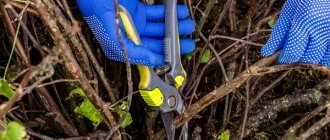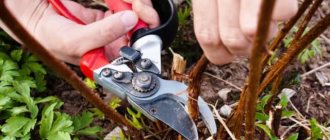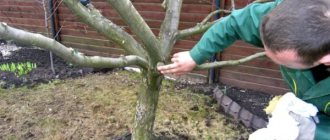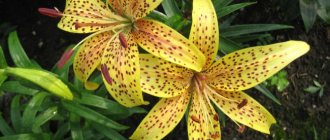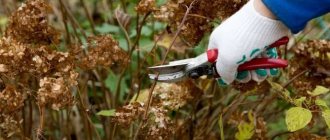Clematis, also known as princelings and clematis, have gained popularity due to their luxurious flowering and ability to entwine country buildings. Liana demands attention. But caring for clematis in the fall will pay off in full next year!
The dacha plot will be transformed as soon as clematis appear on it. These perennial climbing plants attract attention with colorful large or small flowers. The leaves of the vines in green or purple shades and thin flexible stems are also beautiful. Clematis grows quickly and is quite easy to care for. Therefore, now is the time to please yourself with such an unusual green pet and plant it on the site. And if you already have clematis growing, find out how to properly care for it in the fall.
Planting clematis in autumn in open ground
Soil for clematis
Clematis can grow in one place for up to 30 years, so when choosing a place for them, be extremely responsible - although clematis is not capricious, there are conditions under which you cannot achieve normal plant development. For example, in warm areas, clematis should not be planted in bright sun or too close to an iron fence, or near the walls of buildings, since water should not be allowed to drip from the roof onto the clematis.
Do not plant clematis in places where there are drafts, since its flowers are large and heavy, and its shoots are fragile and thin, easily broken by a gust of wind.
Clematis is undemanding in terms of soil composition, but growing it in acidic soil is undesirable - the optimal pH for the plant is 6.5, and the groundwater level should be no higher than 120 cm. Low-lying and wetlands are unsuitable for growing clematis.
- Scilla / scylla: growing in the garden, types and varieties
Autumn planting dates
Clematis is planted in both spring and autumn. If you purchased a seedling in the summer, then it makes sense to plant it in the garden without waiting for spring. When is clematis planted in the ground in the fall? The best time for this is September. If you plant clematis later, it may not have time to take root and will die in the winter. And if you plant it too early, then, having taken root, it can begin to grow, which is also detrimental to the plant on the eve of winter. Therefore, if you received a seedling in November, it is better to leave it in the cellar or basement for the winter and start planting in the spring.
How to plant correctly
Planting clematis in the fall is done in the same way as in the spring - it is planted in the ground with deep penetration, that is, not only the root collar of the seedling should be underground, but also the first pair of buds of the shoot. This planting stimulates tillering and develops plant resistance to diseases.
A hole for clematis is prepared with a depth of at least 60-70 cm. To fill the hole, prepare an earthen mixture consisting of humus, peat, turf soil and sand in equal parts. Add a couple of glasses of wood ash, one glass of lime and 150 g of complex mineral fertilizer to the soil mixture.
Lower the seedling with the earthen ball into the hole, fill it with sand first, and then fill the free space with the earth mixture, lightly trampling it down so that there are no voids left in the soil. After planting, be sure to water the clematis. In the spring, the seedling will begin to grow, but its development will be slow and its shoots will be thin. Don’t despair, this is quite normal - clematis will become a full-fledged ornamental plant only by 3-4 years.
Caring for clematis in autumn
Preparing for winter
Caring for clematis in the fall consists of watering, loosening the soil around the bush, fertilizing, treating against pests and diseases, pruning, preparing the vine for wintering and constructing an air shelter for the winter.
What to feed
How to fertilize clematis in the fall? The last feeding of clematis consists exclusively of mineral fertilizers - a tablespoon of potassium sulfate and superphosphate is dissolved in a bucket of water. Clematis does not need nitrogen at the end of the growing season. Fertilizers are applied in early September.
Watering
Since the hottest days are behind us, watering clematis should be moderate and not too frequent, and if the autumn is rainy, then natural rainfall will be sufficient for clematis.
Treatment
It is not necessary to treat clematis for the winter against diseases and pests, but it is advisable in case harmful insects or pathogens have settled in the plant bark or in the top layer of soil around the bush for the winter. Preventive treatment is carried out with one percent Bordeaux mixture.
Clematis diseases and their treatment
The most dangerous pathology for clematis is wilting. This is a pathology that manifests itself in the drying out of branches. If a plant gets sick during the growing season, this leads to its death. To prevent the problem, it is necessary to ensure proper nutrition of the roots.
Flower diseases also include:
- Spotting is the formation of fungi carried by snails. Brown spots appear on the leaves, causing necrosis. The leaves begin to fall off. Treatment is carried out using copper sulfate.
- Powdery mildew is a pathology that affects the ground part. Growth and flowering stop, the branches become covered with plaque, and the plant gradually dies. Salicylic acid is used for treatment.
Among the pests that clematis are afraid of are nematodes, spider mites and scale insects.
Plant diseases
Why doesn't clematis bloom?
Lack of flowering can occur for various reasons. This may happen if:
- the bush is planted in the wrong place;
- soil is too wet;
- a diseased seedling was used;
- there are not enough nutrients in the soil;
- There are a lot of weeds around the bush;
- The rules were broken during circumcision.
The lack of flowering can be caused by several reasons.
Important! In the first year the plant does not bloom.
Transplanting clematis in the fall to another place
Transplant timing
Sometimes it becomes necessary to transplant clematis from one place to another. What time of year is best to do this? Definitely in the fall. When to replant clematis in the fall? The same time to plant clematis seedlings in open ground - in September, so that the plant has time to take root before the onset of cold weather.
How to replant correctly
Young bushes are easily removed from the soil, after which they are moved with a lump of earth to a new place, but with plants older than 6-7 years you will have to tinker. The difficulty is that adult clematis have powerful long roots, so it is impossible to remove plants from the ground without damaging the root system. And this entails stopping the development of clematis in a new place - next year it is unlikely to bloom, and it will only increase its growth slightly.
An adult clematis needs to be dug around the perimeter to a depth of two shovels, cut off its roots and drag the bush to a new place. When replanting, do not forget to deepen the root collar and the first pair of buds on the lower shoots. As soon as you finish planting, cut off all clematis shoots at the level of two buds.
If you are forced to transplant clematis to another place because of its illness, then before planting, thoroughly wash its roots from the ground, pour a solution of 5 g of Trichloroflora in 10 liters of water into the new planting hole, and after planting, sprinkle the clematis tree trunk circle with wood ash.
When is the best time to plant clematis?
It is important to observe the correct time for planting a flower. The plant belongs to the crop with early growing season
If you do not plant it in a timely manner, the biological rhythm will be disrupted. This will lead to the fact that the flower will not have time to take root before the cold weather.
The timing of planting depends on the region:
- If the procedure is carried out in the spring, it should be done before the buds swell and open. For the central part of Russia, this time begins in mid-April and lasts until early May.
- Clematis that were grown in an apartment are not recommended to be transplanted into open ground until the frosts have passed. A change in temperature will be detrimental to the plant.
- If planting occurs in autumn, it should take place no later than the end of August. This will help the plant take root before frost sets in.
Disembarkation rules
In summer you can plant clematis with a closed root system. To do this, choose a cloudy day. For the winter, the plant is transferred to a greenhouse or apartment, where it grows until it can be transplanted into open ground.
Important! If you purchase a rooted cutting in a store, packaged in a bag with a peat mixture, it cannot be planted in open ground. In the first year, it can only be grown in a deep container, kept warm for the winter.
Only the next year the seedlings are moved into open ground to a permanent place.
Features of planting clematis in the autumn season
Gardeners consider autumn the most suitable time for planting clematis. The plant manages to strengthen the root system before the beginning of winter. The most optimal soil and air temperature for planting is observed in September.
Despite the fact that many varieties of flowers have been bred that tolerate frost well, the autumn plant requires special care. To prepare it for wintering, you will need to carry out a number of activities:
Young seedlings must be covered for the winter. This can be done with dry leaves, branches or improvised material, for example, film, roofing felt. No later than October, the bushes are fed with a mixture of humus and ash. In autumn, stop watering the plant.
It is important to follow this rule, since during night frosts the moisture will destroy the roots. Bushes that are already one year old are completely freed from dry foliage and trimmed. Only the trunk, up to 30 centimeters long, remains. After pruning, clematis is spudded, then covered with branches and film.
Important! If the plant has long shoots, it is rolled up, wrapped in material, laid on the ground and covered with roofing felt. This will protect the roots from moisture
Features of planting clematis in spring
Most varieties of clematis are recommended to be planted only in spring. The vine needs time to properly take root and prepare for winter. A perennial plant planted in the spring will develop a good root system before frost, allowing it to grow for at least twenty years.
Spring planting has its downsides
It is important to meet the deadlines, since the bush begins its growing season very early. If you plant a plant with bare roots and budding buds, it will react sharply to the slightest damage
Therefore, it is important to have time to plant it before the buds open.
Pruning clematis in autumn
When to prune
In areas with warm, long autumns and not very frosty winters, clematis pruning is carried out in early November. In cooler areas, this procedure is done at the end of October, while the weather is good. Choose a dry, fine day and start pruning.
- Don't throw away tea bags - grow seedlings
How to trim
In plants of the first year of life, shoots are cut at a height of 20-30 cm from the surface of the site, leaving 2-3 buds on them - this measure stimulates the development of lateral shoots.
In clematis of the first group, the flowering of which occurs on last year's shoots, diseased, broken, dry and unnecessary shoots are cut out, and the tops of healthy shoots are slightly shortened.
The shoots of clematis of the second group that bloom twice per season are shortened to a height of 1.2-1.5 m, and dry, damaged, diseased and excess shoots are removed at the root.
Clematis of the third group, which bloom only on young shoots of the current year, are pruned like newly planted clematis, leaving only 2-3 buds on the shoots.
There is also a universal way of pruning clematis: one shoot is shortened to 1.5 m, only 2-4 buds are left on the other, and the entire bush is trimmed this way - through the shoot. The point of such pruning is that the bush gradually rejuvenates. In addition, after such pruning on clematis of the second group, in which the first flowering occurs on last year’s shoots, and the second on the current year’s shoots, the flowers will be distributed evenly throughout the bush.
On a note
Gardeners should be prepared for the fact that the first two years after transplantation, clematis will not live up to the pretty pictures. The bush will gain strength and strengthen viable systems (root, stems).
When to replant clematis in the fall: video
In the fourth year, with proper care, the vine will begin to bush and bloom. In order for the plant to grow and produce new shoots, clematis is mulched with leaves, sawdust, and peat.
Low-growing plants are planted next to clematis to help prevent overheating of the root system. They begin to add soil closer to the neck in the spring, after the plant has rooted during the winter. Pinching is used to stimulate new shoots.
Reproduction of clematis in autumn
Reproduction methods
Clematis can be propagated both in spring and autumn. Most often, in autumn, clematis are propagated by dividing the bush, cuttings and autumn layering.
Propagation by autumn cuttings
Cuttings of clematis in the fall are safer and, so to speak, physiological for the plant. How to cut clematis in the fall? Lignified cuttings with one internode and two well-developed buds are cut from the shoots. Under the lower node, the cut should pass through 3-4 cm, and above the top - through 1 cm. The cuttings are treated with phytohormones and buried in a container with a light, loose substrate horizontally at such an angle that there is a layer of soil 3 cm thick above the lower end of the cutting, and above the top – 1 cm.
Containers with cuttings are lowered into the basement and stored there until spring, keeping the substrate slightly moist, and in March, when whitish sprouts appear above the substrate, the containers are transferred to a greenhouse and kept in it, gradually increasing the temperature and regularly moistening the substrate. When the seedlings reach 10 cm, they are pinched to stimulate root development. Cuttings are transplanted into open ground in the spring.
Reproduction by layering
Reproduction by layering is the simplest, least labor-intensive and productive method. Dig up the soil in the place where you are going to take the clematis shoot, level the soil, make a furrow 7-8 cm deep in it, lay the shoot in it, press it to the ground in several places with metal hooks and fill the furrow with humus mixed with peat, or wet ground. The tip of the shoot should remain above the surface. Compact the soil above the layer and water.
For the winter, the place where the cuttings lie needs to be covered with spruce branches and pressed down with a piece of slate. In the spring, remove the cover, and when sprouts appear, mulch the soil around them with peat and water them as needed. In September, the grown seedlings are dug up and transplanted to a permanent place.
Dividing the bush
Clematis that are 5-6 years old are dug up, cut or chopped into several parts, each of which should have good roots and a pair of shoots or at least several buds located on the root neck. Treat the logs and cuts with crushed coal, then place the cuttings in pre-prepared holes and plant as described at the beginning of the article.
If you decide to divide an old clematis bush, dig it on one side to a depth of 50-60 cm, wash the exposed roots from the ground with a stream from a hose so that you can see where to divide the bush. Use an ax or shovel to separate part of the root, process the cuts on the division and old clematis and transplant part of the bush into the prepared hole. After planting, cut off the shoots on the clematis section.
Preparing clematis for winter
Planting clematis and caring for it in the fall could be called an easy and pleasant task if it were not for preparing the plant for wintering, since without shelter it may die. At the end of October or beginning of November, after pruning the clematis, you need to remove leaves and plant debris from under the bush and build a shelter for the plant that is suitable for plants of this group.
Clematis that bloom on last year's shoots are hilled to a height of 30-40 cm or a bucket or two of sand with the addition of wood ash is added to their roots at the rate of 250 g per bucket so that the roots of the plant do not get wet. The scourges are carefully laid on the ground and covered with spruce branches. If you have thaws in winter, you need to lay sawdust or dry peat on top of the spruce branches on the clematis, cover it all with plastic wrap and secure it so that the shelter is not torn off by the wind. It is very important that there is an air gap between the clematis and the shelter.
- Hydrangea: an oriental beauty that loves water
With the onset of spring, the polyethylene is first removed from the clematis, then the layer of substrate, and the spruce branches and sand with ash are left until the spring return frosts have passed, and only after that the clematis is carefully lifted and distributed over the support.
Those clematis that bloom on the shoots of the current year are covered with sand to the height of the shoots remaining after pruning - 15-20 cm, after which they are covered with a layer of sawdust, peat or rotted manure 20-25 cm thick and covered with film.
Proper cultivation of clematis - planting and care in the garden
Or you can cover the clematis with sand and ash, and then cover it with snow. Under cover, plants can survive both frosts up to 40 ºC and thaws without harm to their health.
Bright and unpretentious clematis, choosing varieties for the Moscow region
Clematis are flower-strewn vines that are ideal for vertical gardening, with over 300 species.
Clematis are also called clematis because their fruits have a slightly unpleasant odor.
This is a slightly capricious plant and often does not bloom due to insufficient care or the wrong choice of variety.
If a heat-loving variety is grown in a temperate climate zone, then its flowering is unlikely.
We want to make our site better, but we can't do it without your help. In the comments, you can write to the team of our site, write your opinion about the article and share your experience. Write a comment
This article is about which varieties of clematis to choose for the Moscow region, and what the features of planting and caring for it will be.


